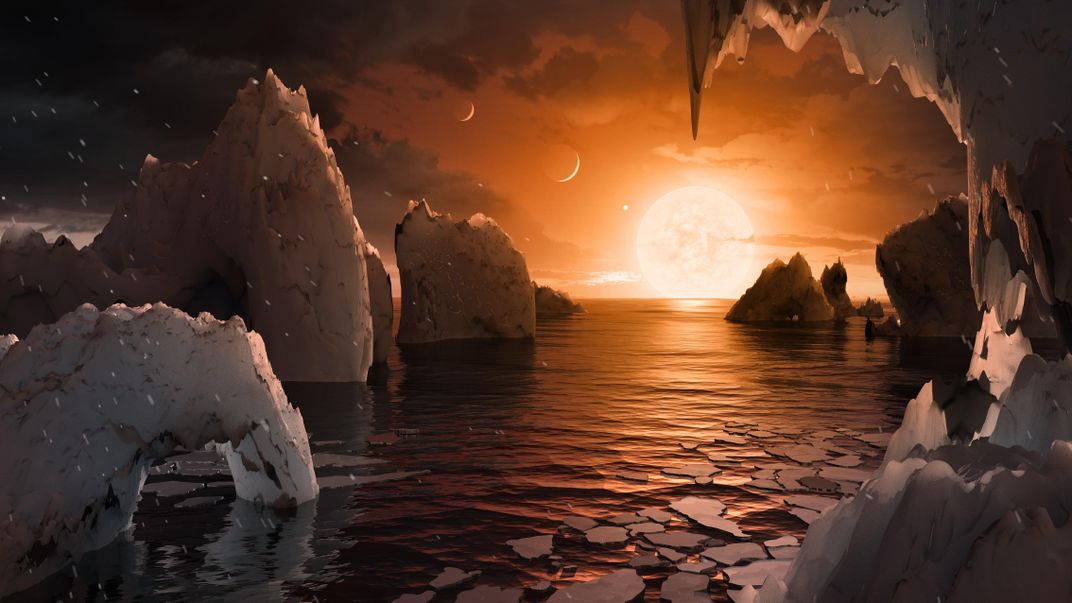Scientists Spot Seven Earth-Sized Planets Orbiting a Nearby Star
This newly discovered solar system presents the best opportunity yet to study potentially habitable worlds, NASA scientists report
/https://tf-cmsv2-smithsonianmag-media.s3.amazonaws.com/filer/72/a4/72a4de93-3e55-41e6-928d-a35ff460b1a6/pia21421.jpg)
A mere 39-light-years away, seven Earth-sized planets appear to be orbiting a star that is smaller and dimmer than our own. What's more, scientists announced today, three of these worlds lie within the star's habitable zone—a region thought to provide the best conditions for life to exist.
"This is the first time that so many planets of this kind have been found around a star," said Michaël Gillon, an astronomer at Belgium's Université de Liège and lead author of the study announcing the discovery published today in the journal Nature.
The star, TRAPPIST-1, has long been ignored by researchers in search of potentially habitable worlds, according to Emmanuël Jehin, an astrophysicist at Université de Liège and another author on the study. Just eight percent the mass of the Sun, it is thought to be much cooler and dimmer than our star. But Gillon saw this as an advantage, because it makes it 80 times easier to spot and measure any potential orbiting bodies.
To detect these other worlds, Gillon and his team used the so-called "transit" method, one of several techniques for hunting planets. Other techniques include measuring the wobble of a star caused by a planet’s gravitational pull, observing how light from a distant star bends around a planet or capturing a direct image of the planet.
The power of the transit method comes from its simplicity: Astronomers measure the level of light from a star, and look for any dips in brightness that could be the result of a planet passing between the star and Earth. By seeing how much and how often the level of light is reduced during each "transit" of the planet in front of the star, astronomers can then estimate its size and orbit.
For large stars, these reductions in light from relatively small planets transiting can be difficult to measure accurately. But because TRAPPIST-1 is so small and dim compared to other stars, astronomers were able to very precisely plot each transit. "Relatively, it would be like Jupiter casting a shadow on our Sun," Gillon says.
Looking at transits, astronomers are normally only able to measure the sizes and orbits of exoplanets. However, TRAPPIST-1's planets have a relatively unique orbital configuration that made it possible to actually estimate the masses of the planets. The planets are very close together, says co-author Amaury Triaud, an astronomer at the University of Cambridge, meaning that their gravities pull on each other, changing the timings of their transits each orbit.
By measuring these changes in the timing, the astronomers could measure their mass to reveal that all seven planets were Earth-sized.

Because the planets lie so close to their star, Gillon says—about 5 percent of the distance from the Sun to Earth—they all have very short orbits, ranging from less than 2 days to roughly 20 days. They are also likely tidally locked to their star, meaning that only side of each planet permanently faces TRAPPIST-1.
TRAPPIST-1's size and dimness will also make it much easier to measure the different molecules found in the planets' atmospheres through spectroscopy—measuring the wavelengths of light passing through the planets' atmospheres. This will give astronomers a better sense of the climates of each exoplanet, and also whether molecules strongly correlated to life are present.
"We can expect that within a few years we will know a lot more about these planets," Triaud says. "And hopefully within a decade [we'll know] if there is life."
To measure these planets, Gillon's team used NASA's Spitzer space telescope along with an array of ground-based telescopes around the world. They are now setting up four small telescopes in Chile that will look exclusively at TRAPPIST-1 and other nearby, ultracool stars for potential exoplanets, and are eagerly awaiting the launch of NASA's James Webb Space Telescope in 2018 will allow even more detailed study of exoplanets.
"We are pioneers," MIT astrophysicist Sarah Sieger said today at an announcement at NASA headquarters in Washington, D.C. "This is a search that will go for many generations."
While there will soon be a lot of eyes on these exoplanets, don't pack your bags for a visit yet. It would take roughly 44 million years to travel the 235 trillion miles to TRAPPIST-1 at the speed of an average jet plane, according to Nikole Lewis, an astronomer researching exoplanet atmospheres at Baltimore's Space Telescope Science Institute. Still, that hasn't stopped other astronomers from getting excited.
"My favorite planet system as of today—so many Earths to choose from!" Dimitar Sasselov, an astronomer at the Harvard-Smithsonian Center for Astrophysics, wrote in an email. The study's authors presented "very solid data" in their announcement, adds Sasselov, who was not involved in the research. But he writes that the future data on the planets' atmospheres means that "the best is still to come."
As NASA associate administrator Thomas Zurbuchen puts it: "This discovery gives us a hint that finding a second Earth is not just a matter of if, but when."